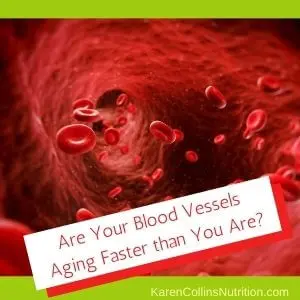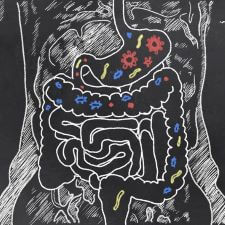
Foods for Vascular Health to Slow Artery Aging
Foods for vascular health ratchet up eating habits’ power to slow artery stiffening. That’s part of how people can be the same age, but differ in “vascular aging”.
This is more than just an interesting concept. – Vascular aging affects heart and brain health even before atherosclerosis and high blood pressure develop, and predicts your risk of heart attack and stroke.
As you get older, your blood vessels show aging by becoming stiffer, less able to relax and contract as they should, and more prone to inflammation and thickening of the walls. But people differ in how fast this vascular aging develops.
So it’s worth looking at how your eating habits may be affecting the aging of your blood vessels.
What is Vascular Aging?
In some people, blood vessels show more aging than would be expected by their chronological age. In others, blood vessels are like those of people 10 or more years younger than they are.
Vascular age involves two components:
- Stiffening of the large elastic arteries – including the aorta that carries blood from the heart to other parts of the body and the carotid arteries that carry blood to the head –
Healthy arteries are elastic, expanding and relaxing with the pulse of blood flow as the heart beats. If arteries become stiff, this forces the heart to work harder. Systolic blood pressure increases, causing blood to flow with a force that can damage tissues like the brain and kidney and increase risk of stroke. - Endothelial dysfunction —
The vascular endothelium is a single layer of cells that lines the inside of blood vessels. It’s not just a wall. It plays an active role in keeping a healthy balance as blood vessels contract and relax. Endothelial dysfunction occurs when these cells lose control of when and how much blood vessels constrict. And that sets the stage for atherosclerotic plaque that underlies cardiovascular disease.
Vascular Health & Aging
Vascular age varies: In a cross-sectional study of over 18,000 adults without cardiovascular disease, researchers looked at the variation in signs of artery aging. People who showed the least blood vessel stiffness were classified as having healthy vascular aging. [Blood vessel stiffness was assessed using a non-invasive test called pulse wave velocity (PWV), testing how long it takes the pulse wave of blood flow to travel between two spots, such as from the carotid artery to the chief artery of the thigh.]
- Among people the same age, heathy vascular aging was most likely in people without obesity, diabetes, hypertension or metabolic syndrome.
- When comparing people with similar levels of cardiovascular risk factors (like blood lipids, blood pressure and blood sugar), people with healthy vascular aging showed blood vessel health comparable to other people in the study up to 14 years younger.
Vascular age predicted development of cardiovascular disease almost 10 years in advance: In an investigation from the Framingham Heart Study, adults age 50 and older were classified as having healthy vascular aging if they had both normal blood pressure and blood vessel stiffness near the level of healthy people age 30 or younger.
- In this study, only 30% of people ages 50 to 59, and only 7% of those ages 60 to 69, met criteria for healthy vascular aging.
- After 9.6 years, people originally identified with healthy vascular aging developed only one-third of the cardiovascular disease as the rest of the group (after adjusting for age and gender).
- Researchers even accounted for heart disease risk factors like blood cholesterol, diabetes, smoking, blood pressure and overweight or obesity in their analysis. Still, people initially designated as showing healthy vascular aging were less than half as likely to have developed cardiovascular disease or to have had a cardiovascular event (heart attack, stroke or death) compared to people who did not start with healthy vascular aging. These findings are consistent with results of other studies.
How Blood Vessel Health Changes with Age 
Multiple influences seem to interact with each other, leading to changes in the actual structure of blood vessels and in how they function. Researchers are studying these processes, hoping to find ways to prevent, delay or even reverse the changes that cause blood vessels to stiffen and lose their ability to expand and relax appropriately.
- Highly reactive molecules in the body commonly called free radicals can come from exposure to hazards like tobacco smoke and pollution. Yet they also develop as part of normal metabolic processes. We need some free radicals for signaling systems in our cells. However, oxidative stress occurs when levels get too high, which can promote damage to blood vessels.
- Oxidative stress and chronic inflammation create a vicious cycle, each increasing the other. They seem to be major contributors to stiffening of large arteries and decreased ability of the endothelial cells that line blood vessels to keep arteries dilating and constricting properly.
- Insulin resistance reduces endothelial cells’ production of a compound called nitric oxide that supports blood vessels’ ability to relax. Reduced nitric oxide leads to blood vessel constriction and stiffening and to more inflammation. Insulin resistance occurs when body cells don’t respond well to insulin, and the body increases circulating levels of insulin in an attempt to compensate. Insulin resistance also promotes endothelial dysfunction by increasing oxidative stress and chronic inflammation.
- Artery stiffness and blood pressure each influence the other. Earlier, scientists thought high blood pressure caused artery stiffness. Now research shows that your arteries may show stiffening before blood pressure starts increasing and that stiffening may lead to rising blood pressure. Yet higher systolic blood pressure may in turn promote stiffening of the aorta.
- Laboratory studies in animals support the idea that changing these influencing factors can change development of vascular aging. Exposing young animals to these pro-inflammatory factors can cause structural and functional changes in blood vessels seen in aging. And reducing low-grade inflammatory signaling in older animals can reduce endothelial dysfunction and thickening and stiffening of artery walls.
Eating Habits to Support Healthy Blood Vessels
What you eat and drink can help protect your blood vessels in multiple ways. And there’s room for you to include these strategies in healthy eating habits that fit your individual preferences and lifestyle.
Strategy #1: Amp up your use of plant foods rich in polyphenols and other phytocompounds.
Polyphenol-rich foods seem to reduce artery stiffness, and may help reduce systolic blood pressure. These phytocompounds (natural compounds in plant foods) seem to turn on antioxidant, anti-inflammatory defenses. Reduced artery stiffness has been demonstrated not only in animals, but also in human studies.
- Berries are especially rich in anthocyanins and other flavonoid polyphenols. Studies show strong potential for supporting healthy blood vessels, and reducing oxidative stress and inflammation.
- Walnuts provide polyphenols, as well as the amino acid L-arginine that blood vessels’ endothelial cells use to produce the nitric oxide that supports blood vessel ability to relax. This may be one of the reasons that increasing consumption of walnuts, and nuts in general, is linked with lower risk of cardiovascular disease in large population studies.
- Tea (both green and black), coffee, cocoa and dark chocolate bring other flavonoid polyphenols that improve endothelial function and may reduce artery stiffness.
- Extra virgin olive oil is heart-healthy for more than its unsaturated fat. Growing evidence from population studies and controlled trials shows that olive oil polyphenols may promote endothelial function.
Carotenoid compounds deliver antioxidant protection and seem to trigger body antioxidant, anti-inflammatory defenses.
- Dark green vegetables are top sources of the carotenoids beta-carotene and lutein. Experiment with new ways to include dark leafy greens like spinach; kale; collard, mustard and turnip greens; bok choy; and arugula as frequent choices in your meals. For salad greens, romaine and leaf lettuce (as well as kale and arugula) provide more carotenoids than pale greens like iceberg lettuce.
- Deep orange choices are uber-rich in carotenoids, too. That means carrots, winter squash, cantaloupe and more.
Nitrate-rich vegetables provide additional help for the body to produce the nitric oxide that helps blood vessels relax and dilate.
- Spinach, kale, beets and celery are some of the vegetables highest in nitrates.
Cruciferous and onion family vegetables offer unique phytocompounds like isothiocyanates and allyl sulfur compounds. Cruciferous vegetables include broccoli, Brussels sprouts, cauliflower and many more. Soy foods (like edamame and tofu) provide isoflavone compounds. Evidence is more limited, especially from human studies, about these compounds and vascular health. But laboratory studies consistently suggest potential to support antioxidant and anti-inflammatory defenses.
Strategy #2: Include plant foods that feed a healthy gut microbiome.

- Pulses are a major source of prebiotic carbohydrate that are well worth including in meals more often. These include dried beans (like black beans and kidney beans), lentils, split peas, and chickpeas (garbanzo beans).
- Examples of foods that have prebiotics also include vegetables such as Jerusalem artichokes (also called “Sunchokes”), globe artichokes (what most people think of when they hear “Artichokes”), onions, garlic, leeks, and asparagus.
- Cereals and bars with chicory root fiber (inulin) are also a source of an established prebiotic.
Foods with fermentable fiber provide a carbohydrate that gut microbes use to produce anti-inflammatory fatty acids. These unique fatty acids seem to suppress development of inflammation in the gut and throughout the body. Different types of dietary fiber offer different forms of protective benefits. It’s important for most of us to eat more fiber-rich foods. And advances in research show more than ever that we need a variety of fiber types.
- Oatmeal and barley are whole grains that provide fermentable fiber. Include them often as part of the three or more daily modest size servings of whole grains — such as a one-ounce slice of bread or serving of cereal, or ½ cup of cooked whole grains. All kinds of whole grains provide polyphenol compounds that can contribute to anti-oxidant, anti-inflammatory defenses.
- Pulses – lentils and dry beans and peas – provide fermentable fiber in addition to their prebiotic carbohydrate. For overall health, start by aiming for at least three half-cup servings of pulses each week. Then consider trying for more, since higher amounts have been linked with even lower heart disease risk.
Use pulses to replace some of the meat in tacos, chili, and stews. Add them to salads, soups and pasta dishes. Have fun exploring the wide range of dips that start by blenderizing beans. For more on how pulses are a plus for health and easy ideas for making them part of everyday eating, check this research brief on pulses.
Strategy #3: Explore foods supplying omega-3 fat.

Recommendations for heart-healthy eating advise eating seafood twice a week, since it offers several benefits for heart health. But choose wisely. Deep-fried or batter-covered fish is not providing these benefits.
- For at least some of those weekly servings, if you zero in on cold water fish naturally higher in fat, they provide more omega-3 fatty acids.
Some plant foods are rich in a different omega-3 fat that may also lend anti-inflammatory protection and support normal blood vessel function.
- Walnuts contain more of this plant omega-3 fatty acid than any other nuts. That’s another reason to enjoy them as a much more nutritious source of crunch in green salads than croutons. Mix them into tuna salad and cooked grains and vegetables, too. Or use them as toppings for yogurt and oatmeal. See how they partner with other protectors of vascular health?
- Flaxseeds and chia seeds are rich in this omega-3 fat, too. In order to absorb the heart-healthy fat from flaxseed, make sure to grind it first. You can buy it pre-ground and keep it refrigerated. Or if you enjoy homemade smoothies, add flaxseed and let the blender do the grinding for you. Or grind them in a coffee grinder before adding to cereal or other foods.
Strategy #4: Reduce use of high-sodium processed foods.

Common ultra-processed foods account for most of today’s sodium load. So look beyond your saltshaker. The good news is that you can still enjoy tasty, convenient food and achieve meaningful reductions with some simple sodium-cutting tweaks for healthy eating.
Bottom Line on Foods for Vascular Health
You can strengthen a heart-healthy, plant-based diet by paying attention to food choices. Include vegetables, fruits, whole grains, pulses, nuts and seeds throughout the day. And seafood makes a noteworthy addition to heart-healthy eating. Focus on variety in these foods. That will amplify the protective potential of their nutrients, phytocompounds and dietary fiber. Besides, variety helps keep plant-focused eating habits interesting and enjoyable!
⇒ Want a free tip sheet? This checklist shows how to use variety in food choices to make healthy eating easier, and how to get past the barriers that too much variety can pose. These are the practical ideas that help you put the research on vascular health into action.
To get the checklist… and get future research updates straight to your email inbox:
For ideas and tips on using these foods to create heart-healthy eating patterns, I encourage you to check these resources:
Jazz up your usual veggie repertoire with some new recipes from the Produce for Better Health Foundation. You can even narrow your focus to options that are quick and easy or budget-friendly.
If you’re stuck in a rut with only a few dishes that include pulses like dry beans and lentils, grab some easy ideas from USA Pulses. You’ll even find a section here showing three different ways to serve four of the most popular pulses.
You’ll find tip sheets on cooking fish and shellfish (including how to defrost frozen fish) and on buying seafood (including the scoop on sustainable fish) from the Seafood Nutrition Partnership.
1. Nilsson PM, Laurent S, Cunha PG, et al. Characteristics of healthy vascular ageing in pooled population-based cohort studies: the global Metabolic syndrome and Artery REsearch Consortium. Journal of Hypertension. 2018;36(12):2340-2349.
2. Niiranen TJ, Lyass A, Larson MG, et al. Prevalence, Correlates, and Prognosis of Healthy Vascular Aging in a Western Community-Dwelling Cohort. Hypertension. 2017;70(2):267-274.
3. Wang M, Monticone RE, McGraw KR. Proinflammatory Arterial Stiffness Syndrome: A Signature of Large Arterial Aging. Journal of Vascular Research. 2018;55(4):210-223.
4. Nowak KL, Rossman MJ, Chonchol M, Seals DR. Strategies for Achieving Healthy Vascular Aging. Hypertension. 2018;71(3):389-402.
5. Johnson SA, Litwin NS, Seals DR. Age-Related Vascular Dysfunction: What Registered Dietitian Nutritionists Need to Know. J Acad Nutr Diet. 2019;119(11):1785-1796.
6. Liu X, Guasch‐Ferré M, Drouin‐Chartier JP, et al. Changes in Nut Consumption and Subsequent Cardiovascular Disease Risk Among US Men and Women: 3 Large Prospective Cohort Studies. J Am Heart Assoc. 2020;9(7):e013877.
7. Schwingshackl L, Christoph M, Hoffmann G. Effects of Olive Oil on Markers of Inflammation and Endothelial Function—A Systematic Review and Meta-Analysis. Nutrients. 2015;7(9):7651-7675.
8. Sanchez-Rodriguez E, Lima-Cabello E, Biel-Glesson S, et al. Effects of Virgin Olive Oils Differing in Their Bioactive Compound Contents on Metabolic Syndrome and Endothelial Functional Risk Biomarkers in Healthy Adults: A Randomized Double-Blind Controlled Trial. Nutrients. 2018;10(5).
9. Catry E, Bindels LB, Tailleux A, et al. Targeting the gut microbiota with inulin-type fructans: preclinical demonstration of a novel approach in the management of endothelial dysfunction. Gut. 2018;67(2):271-283.
10. Zehr KR, Walker MK. Omega-3 polyunsaturated fatty acids improve endothelial function in humans at risk for atherosclerosis: A review. Prostaglandins & Other Lipid Mediators. 2018;134:131-140.
11. LaRocca TJ, Martens CR, Seals DR. Nutrition and other lifestyle influences on arterial aging. Ageing Research Reviews. 2017;39:106-119.
Top image (blood vessel): Sebastian Kaulitzki – Copyright 123rf.com – 18448622_m
Phytocompound-rich plant foods: Marilyn Barbone – Copyright 123rf.com – 58544580_m
Gut microbiota illustration: – Illustrator – Copyright 123rf.com – 54767380_s
1 Comments
Leave a Comment
Published : April 8, 2020 | Last Updated: April 9, 2020
Tagged: antioxidants, artery stiffness, foods for vascular health, healthy blood vessels, healthy diet, healthy eating, heart health, high blood pressure, inflammation, phytocompounds, plant-based diet, polyphenols, prebiotics, vascular aging
Meet the author/educator
I Take Nutrition Science From Daunting to Doable.™
As a registered dietitian nutritionist, one of the most frequent complaints I hear from people — including health professionals — is that they are overwhelmed by the volume of sometimes-conflicting nutrition information.
I believe that when you turn nutrition from daunting to doable, you can transform people's lives.
Accurately translating nutrition science takes training, time and practice. Dietitians have the essential training and knowledge, but there’s only so much time in a day. I delight in helping them conquer “nutrition overwhelm” so they can feel capable and confident as they help others thrive.
I'm a speaker, writer, and nutrition consultant ... and I welcome you to share or comment on posts as part of this community!





Thank you so much for sharing this. Also, at the same time, preclinical models should continue to be utilized to discern the mechanisms modulating HVA in both healthy aging and diseased populations.